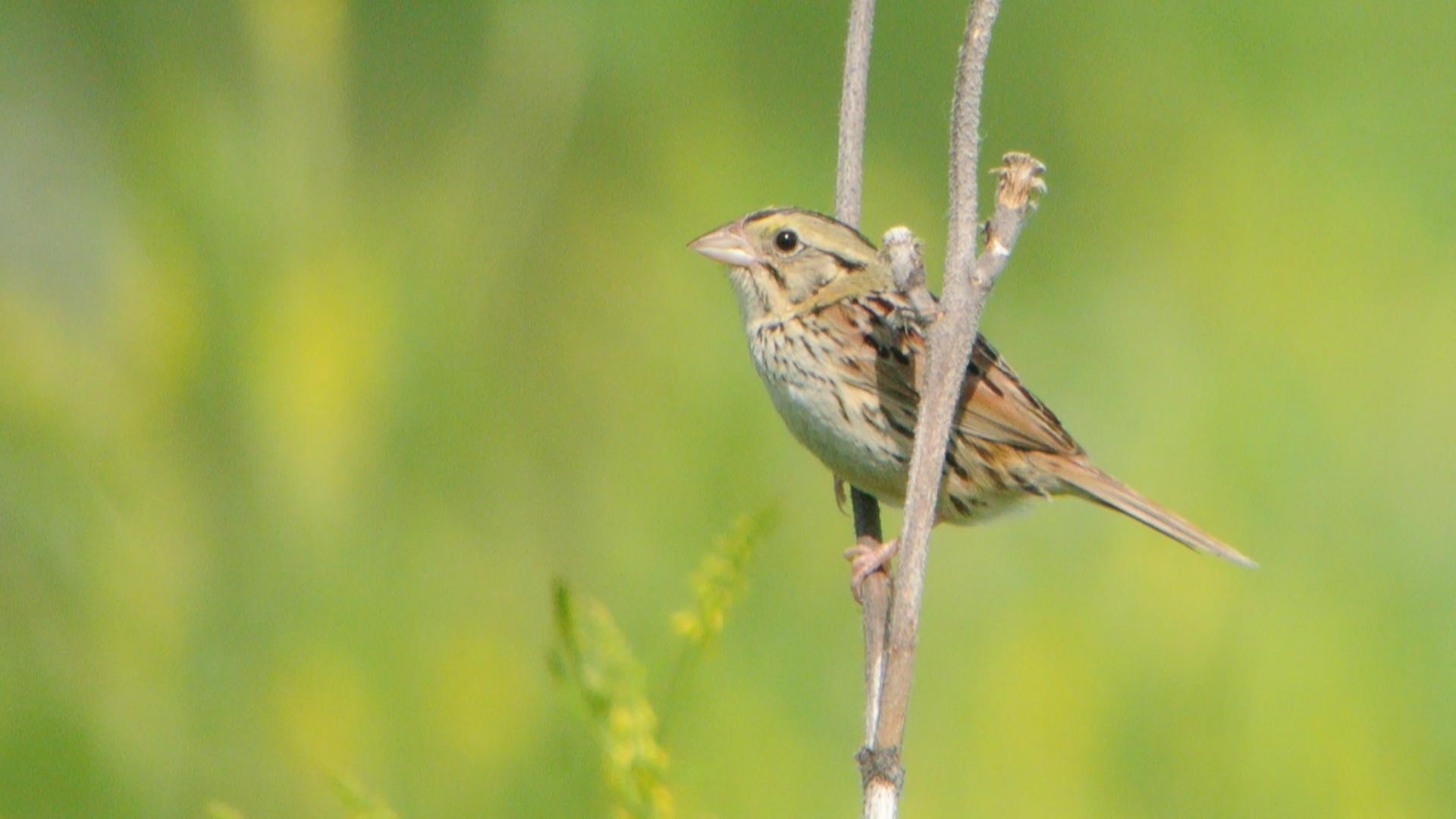Henslow's Sparrow
A species of Grassland sparrows Scientific name : Centronyx henslowii Genus : Grassland sparrows
Henslow's Sparrow, A species of Grassland sparrows
Botanical name: Centronyx henslowii
Genus: Grassland sparrows
Content
Description General Info
 Photo By Andy Reago & Chrissy McClarren , used under CC-BY-2.0 /Cropped and compressed from original
Photo By Andy Reago & Chrissy McClarren , used under CC-BY-2.0 /Cropped and compressed from original Description
Adults have streaked brown upperparts with a light brown breast with streaks, a white belly and a white throat. They have a pale stripe on the crown with a dark stripe on each side, an olive face and neck, rust-coloured wings and a short dark forked tail. Measurements: Length: 4.3-5.1 in (11-13 cm) Weight: 0.4-0.5 oz (11-15 g) Wingspan: 6.3-7.9 in (16-20 cm) 
Size
14 cm
Life Expectancy
6.5-7 years
Nest Placement
Ground
Clutch Size
3 - 4 eggs
Incubation Period
2 - 3 broods
Number of Broods
10 - 12 days
Feeding Habits
Henslow's Sparrow's diet varies seasonally, consuming insects like grasshoppers, beetles, and caterpillars during summer. In winter, henslow's Sparrow forages on the ground for seeds from wiregrass, sedges, ragweed, smartweed, as well as occasional berries.
Habitat
Henslow's Sparrow primarily inhabit open grasslands, including weedy pastures, wet meadows, and native prairies. This bird shows a preference for large, dense grass fields, notably avoiding areas close to trees or woody vegetation. Henslow's Sparrow are also known to adapt to human-altered landscapes, such as cultivated hayfields and reclaimed surfaces in the Ohio River basin. The species has historically utilized Atlantic coastal marshes and continues to occupy fire-maintained pine savannahs, especially during winter when their habitat tolerance slightly increases to include areas with more trees.
Nest Behavior
Henslow's Sparrow engages in nest building predominantly in grass-dominated habitats. The female is responsible for constructing the nest during the breeding season, and after building, she lays the eggs. Both parents participate in nurturing and protecting the hatchlings until fledging.
Nest Characteristics
Henslow's Sparrow's nest is typically located on or very near the ground, nestled at the base of dense grass clumps within thick leaf litter. The female constructs the nest using dried grasses, forming a loosely woven cup on top of the vegetation or leaf litter.
Dite type
Insectivorous
General Info
Feeding Habits
Bird food type
Behavior
Henslow's Sparrow exhibits extreme secrecy year-round, primarily conducting activities such as foraging for insects and seeds on or near the ground. They demonstrate a loose colonial nesting pattern with pairs staying close yet maintaining distinct territories divided by an unclaimed buffer zone. Territorial males alternately sing from exposed perches or while concealed on the ground. On wintering grounds, documenting henslow's Sparrow's behavior proves challenging due to their heightened secrecy and quietness.
Distribution Area
Their breeding habitat is shrubby fields, often wet, in southern Canada, the northeastern United States, and the midwestern United States. The nest is a well-concealed open cup on or close to the ground in a grassy location; these birds often nest in small colonies. They migrate to marshes and open pine woods in the southeastern United States. These birds forage on the ground, mainly eating insects and seeds. Their song is a quick se-lick. The range and numbers of this bird are decreasing, probably due to habitat loss of the grasslands that it depends on. However, it has heavily benefited from the Conservation Reserve Program formed by the United States Department of Agriculture, which has helped to stabilize its population. Following this, it was downlisted to Least Concern from Near Threatened in 2018. The Texas population was solely known from a 105-acre (0.42 km) brushfield near Houston and disappeared after devegetation due to industrial development in the 1980s. It was considered a distinct subspecies (P. h. houstonensis: Arnold, 1983) but is today considered to fall into the range of variation of the nominate subspecies (Browning, 1990). Likewise, the South Dakotan population formerly known as P. h. occidentalis has been synonymized with the nominate. The only remaining subspecies generally (but not universally) accepted are the eastern Henslow's sparrow and the western Henslow's sparrow, whose ranges are for the most part separated by the Appalachian Mountains. 

 Photo By Andy Reago & Chrissy McClarren , used under CC-BY-2.0 /Cropped and compressed from original
Photo By Andy Reago & Chrissy McClarren , used under CC-BY-2.0 /Cropped and compressed from original Scientific Classification
Phylum
Chordates Class
Birds Order
Perching birds Family
New world sparrows Genus
Grassland sparrows Species
Henslow's Sparrow